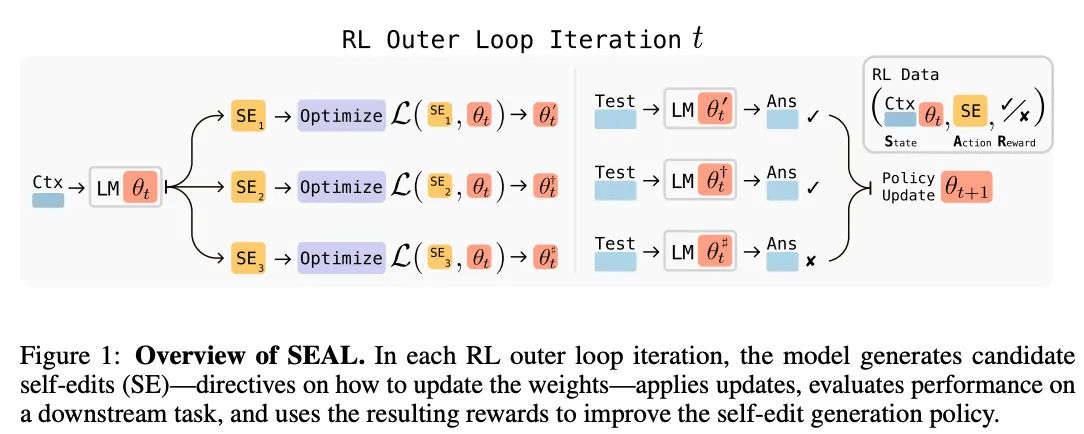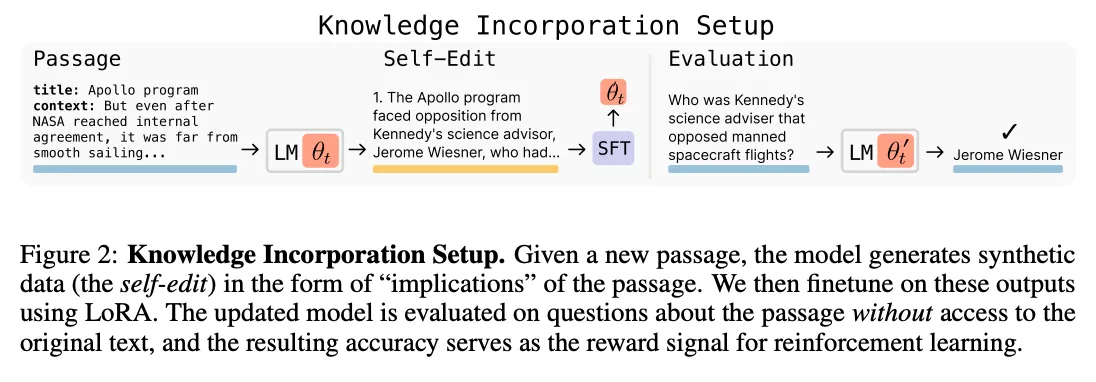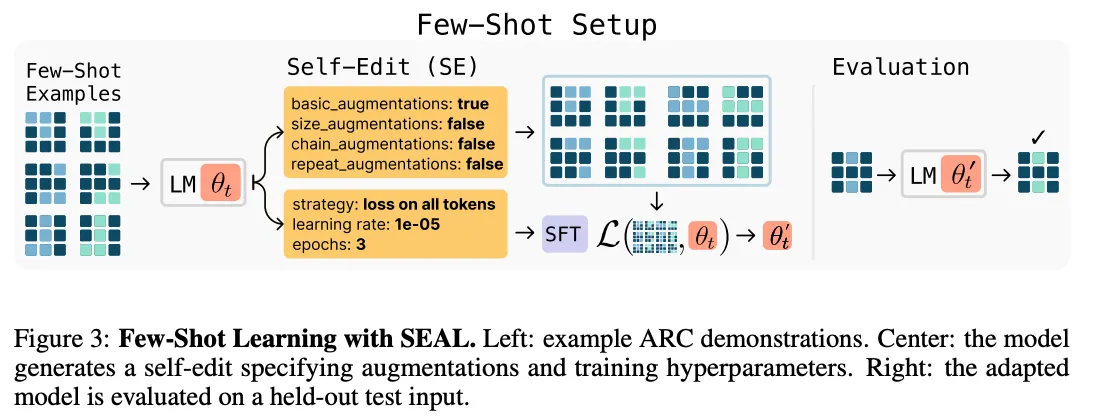First things first – Why This Paper Matters
Large language models (LLMs) are powerful but static: once trained, they can’t easily incorporate new information or adapt to novel tasks without expensive retraining. In practice this means your chatbot’s knowledge freezes at the training cutoff, and it “forgets” any new breakthroughs after that. Common fixes – fine-tuning (slow, data-hungry), in-context tricks (limited examples), or search tools (still only in-context) – have serious drawbacks.
Self-Adapting LLMs (SEAL) tackles this head-on. Rather than treating an LLM as a fixed function, SEAL teaches it to generate its own training data and update instructions. In other words, the model literally writes the lesson plan for its next round of learning. The paper’s core claim is that an LLM can use its own output (a “self-edit”) to finetune itself and thus persistently update its knowledge. This could be a game-changing leap toward LLMs that don’t just parrot their training data, but actually self-improve over time. In fact, experiments on adding new facts and tackling few-shot problems show SEAL is “a promising step toward language models capable of self-directed adaptation”. That’s why this MIT study matters: it’s an early stab at continuous learning for LLMs, pushing us past the static mindset.
Core Concept Explanation
At SEAL’s heart lies a self-edit. Suppose you hand the model a Wikipedia paragraph about Mars. The model is asked to:
- Generate a helpful derivative of that paragraph – for example,
- a bullet list of salient facts,
- a set of question → answer pairs, or
- a short explanation aimed at sixth-graders.
- Fine-tune itself on that derivative using a tiny, fast adapter (LoRA).
- Check whether its post-update answers actually improved.
That sequence yields two nested loops:
| Loop | Who does the work? | What happens? | Frequency |
|---|---|---|---|
| Inner loop (learning) | LLM + LoRA | Apply the freshly generated self-edit as training data and update weights. | Once per self-edit |
| Outer loop (selection) | Reinforcement Learning (ReST-EM) | Keep only the self-edits that improve the model on held-out questions; discard the rest. | Repeats for many batches |

Figure 1: Overview of the SEAL framework. In each iteration the model generates candidate self-edits, applies them via weight updates, then uses the resulting performance to refine its editing policy.
Experimental Setup
SEAL is validated on two complementary tasks:
-
Knowledge Incorporation (SQuAD passages)
The model sees a news-style paragraph once, must absorb the facts, and later answer questions without the paragraph. -
Few-Shot Reasoning (ARC puzzles)
The model gets a handful of coloured-grid puzzles and must infer the underlying pattern to solve a new grid.
For both tasks SEAL is compared against:
| Baseline | Description |
|---|---|
| Frozen model | No updates, no context (hardest). |
| Prompt-only / CoT | Careful in-context examples, but no weight updates (ARC only). |
| Raw fine-tune | Fine-tune on the passage itself (SQuAD) or simple augmentations (ARC). |
| Synthetic-data w/o RL | Let the base model (or GPT-4.1) generate extra data, then fine-tune once. |
All runs use small LoRA adapters so each inner-loop update costs seconds, not hours.
Evaluation Strategy (what “better” means)
-
Exact-match accuracy
- SQuAD: answer string must match the ground-truth span.
- ARC: produced grid must equal the target grid pixel-perfectly.
-
Pass@1 vs. Pass@k
For ARC, the authors take the best of k self-edits; Pass@k reports the chance at least one edit solves the puzzle. Main table shows k = 5. -
Reward signal in RL: +1 if the accuracy after the update is higher than before; 0 otherwise.
-
Catastrophic forgetting check
After many sequential edits, they re-test old questions to see how much performance dropped.
Performance Breakdown
SEAL showed notable gains over baseline approaches in both experiments:
-
Adding New Facts (SQuAD): Without any adaptation, the base model gets about 32.7% of questions right on a passage (no context). Fine-tuning on the raw passage only barely helps. Using synthetic data from a stronger model (GPT-4.1) gives ~46.3% accuracy. Crucially, after two rounds of SEAL’s RL loop, the model jumps to 47.0% – beating even the GPT-4.1 data without being that large.
-
Many Passages: When given 200 passages in sequence, SEAL again tops the chart at 43.8% correct, compared to ~39.4% using GPT-4.1 synthetic data and ~32–41% for other baselines.
-
Few-Shot Learning (ARC): The ARC questions were extremely challenging without learning: zero-shot in-context fails completely (0% success). Simply finetuning on naive self-edits (without RL) yields 20%. With SEAL’s self-directed training, success soars to 72.5%.

Figure 2: Knowledge integration accuracy on SQuAD-style tasks.

Figure 3: Few-shot generalization (ARC task).
Practical Notes for Researchers & Builders
- Check for catastrophic forgetting: Measure what new training overwrites. Consider hybrid fixes (retrieval augmentation, regularization).
- Budget for compute: SEAL’s RL loop is GPU-intensive. Profile carefully.
- Align token budgets: Chain-of-thought self-edits may need more tokens. Adjust context length accordingly.
- Compare to strong baselines: SEAL outperformed GPT-4.1 synthetic data – test against top-tier generators.
- Combine neural and symbolic: Use test suites or symbolic checkers to verify neural self-learning outputs.
Critical Review of the paper
1. Does this research really matter?
Yes. It moves beyond prompt tricks toward persistent model improvement, a core need for real-world deployments. But is this really “learning” or just “memorizing”, I leave that upto you to decide!
2. Does the methodology actually make sense?
Mostly. Using RL with an inner LoRA-based update is sensible, but the approach is compute-heavy and bounds chain-of-thought prompt lengths.
3. Are the conclusions measured or melodramatic?
The authors are appropriately cautious, calling SEAL “a promising step” rather than a revolution.
4. Novelty check: wasn’t this known already?
Similar synthetic data generation exists, but SEAL’s RL-driven self-edit policy and end-to-end evaluation is novel. That said, you won’t be wrong in suspecting if OpenAI, Meta and others might have something similar going for themselves already.
5. Strengths and Weaknesses
Strengths: Code released, convincing benchmarks, honest limitations.
Weaknesses: Toy tasks, compute costs, catastrophic forgetting, prompt sensitivity, SEAL needs to be tested & improved on more “reasoning” based benchmarks
6. Final Verdict
A well-executed proof-of-concept that opens an exciting direction for continuous LLM learning. Not a silver bullet, but a strong foundation for future work.

Ask That Llama!
Try these prompts on your favorite LLM to explore more about this topic by yourself:
🧪 1. Explore concrete reasoning about when to update weights versus stay stateless.
🧠 2. GIGO: Garbage-In-Garbage-Out?
⚠️ 3. Limitations of Self-Learning: Why can't this scale forever?
